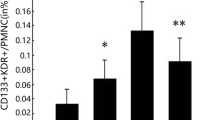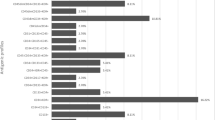Abstract
Kawasaki disease (KD) is associated with coronary artery injury. Studies have shown that the endothelial progenitor cell (EPC) participates in the process of arterial repair. Data have been reported that the number of EPC increased significantly in the subacute phase of KD. However, until now, there are no data about the functions of EPC in KD patients. The present study was designed to further investigate the number and functions of EPC in KD. Ten KD patients in the acute phase and ten healthy volunteers were recruited and attributed to the KD group and control group, respectively. The circulating CD34/kinase insert domain-containing receptor double positive cells were evaluated in the two groups using flow cytometry. In vitro assays were used to measure the functions of EPC, including proliferation, adhesion, and migration activities. The plasma levels of nitric oxide (NO), tumor necrosis factor-α (TNF-α), and high sensitivity C-reactive protein (hs-CRP) were also assessed in both groups. The number of EPC in the KD group was significantly higher than that of the control group (0.021 ± 0.007% vs. 0.014 ± 0.003%, P < 0.05). The migratory response of EPC was significantly decreased in the KD group, compared with that of the control group (5.50 ± 1.78 vs. 3.40 ± 1.35 cells/high power field, P < 0.01). Similarly, the proliferative and adhesive activities of EPC in the KD group were also decreased (0.47 ± 0.08 vs. 0.66 ± 0.07, P < 0.01; 6.5 ± 2.12 vs. 11.2 ± 2.04 cells/high power field, P < 0.01). The plasma NO, TNF-α, and hs-CRP levels in the KD group were higher than those of the control group (54.10 ± 11.78 vs. 38.80 ± 11.10 μmol/l, P < 0.01; 48.20 ± 7.42 vs. 37.00 ± 11.12 pg/ml, P < 0.05; 87.10 ± 30.18 vs. 5.30 ± 3.37 mg/l, P < 0.01). The number of circulating EPC positively correlated with the level of NO (r = 0.92, P < 0.001), and the functions of EPC negatively correlated with the levels of TNF-α and hs-CRP, respectively. In Kawasaki disease, the number of EPC was enhanced and the functions of EPC were attenuated. The two-way regulation of circulating EPC in KD patients may be associated with the disorders of cytokines or messengers in KD patients.








Similar content being viewed by others
References
Aicher A, Heeschen C, Mildner-Rihm C et al (2003) Essential role of endothelial nitric oxide synthase for mobilization of stem and progenitor cells. Nat Med 9:1370–1376
Aicher A, Zeiher AM, Dimmeler S (2005) Mobilizing endothelial progenitor cells. Hypertension 45:321–325
Asahara T, Murohara T, Sullivan A, Silver M et al (1997) Isolation of putative progenitor endothelial cells for angiogenesis. Science 275:964–967
Asahara T, Takahashi T, Masuda H et al (1999) VEGF contributes to postnatal neovascularization by mobilizing bone marrow-derived endothelial progenitor cells. EMBO J 18:3964–3972
Awata T, Kurihara S, Takata N et al (2005) Functional VEGF C-634G polymorphism is associated with development of diabetic macular edema and correlated with macular retinal thickness in type 2 diabetes. Biochem Biophys Res Commun 333:679–685
Bacon PA (2005) Endothelial cell dysfunction in systemic vasculitis: new developments and therapeutic prospects. Curr Opin Rheumatol 17:49–55
Borzutzky A, Gutierrez M, Talesnik E et al (2008) High sensitivity C-reactive protein and endothelial function in Chilean patients with history of Kawasaki disease. Clin Rheumatol 27:845–850
de Groot K, Goldberg C, Bahlmann FH et al (2007) Vascular endothelial damage and repair in antineutrophil cytoplasmic antibody-associated vasculitis. Arthritis Rheum 56:3847–3853
Dhillon R, Clarkson P, Donald AE et al (1996) Endothelial dysfunction late after Kawasaki disease. Circulation 94:2103–2106
Diller GP, van Eijl S, Okonko DO et al (2008) Circulating endothelial progenitor cells in patients with Eisenmenger syndrome and idiopathic pulmonary arterial hypertension. Circulation 117:3020–3030
He T, Smith LA, Harrington S et al (2004) Transplantation of circulating endothelial progenitor cells restores endothelial function of denuded rabbit carotid arteries. Stroke 35:2378–2384
Henrich D, Seebach C, Wilhelm K et al (2007) High dosage of simvastatin reduces TNF-alpha-induced apoptosis of endothelial progenitor cells but fails to prevent apoptosis induced by IL-1beta in vitro. J Surg Res 142:13–19
Herbrig K, Haensel S, Oelschlaegel U et al (2006) Endothelial dysfunction in patients with rheumatoid arthritis is associated with a reduced number and impaired function of endothelial progenitor cells. Ann Rheum Dis 65:157–163
Hill JM, Zalos G, Halcox JP et al (2003) Circulating endothelial progenitor cells, vascular function, and cardiovascular risk. N Engl J Med 348:593–600
Holmen C, Elsheikh E, Stenvinkel P et al (2005) Circulating inflammatory endothelial cells contribute to endothelial progenitor cell dysfunction in patients with vasculitis and kidney involvement. J Am Soc Nephrol 16:3110–3120
Huang SM, Weng KP, Chang JS et al (2008) Effects of statin therapy in children complicated with coronary arterial abnormality late after Kawasaki disease: a pilot study. Circ J 72:1583–1587
Ikeda M, Furukawa H, Imamura H et al (2002) Surgery for gastric cancer increases plasma levels of vascular endothelial growth factor and von Willebrand factor. Gastric Cancer 5:137–141
Ikemoto Y (2003) Nitric oxide in Kawasaki disease. J Pediatr 142:594–595 author reply 595-596
Jun CD, Choi BM, Hoon R et al (1994) Synergistic cooperation between phorbol ester and IFN-gamma for induction of nitric oxide synthesis in murine peritoneal macrophages. J Immunol 153:3684–3690
Kariyazono H, Ohno T, Khajoee V et al (2004) Association of vascular endothelial growth factor (VEGF) and VEGF receptor gene polymorphisms with coronary artery lesions of Kawasaki disease. Pediatr Res 56:953–959
Kawasaki T (1967) Acute febrile mucocutaneous syndrome with lymphoid involvement with specific desquamation of the fingers and toes in children. Arerugi 16:178–222
Kawasaki T, Kosaki F, Okawa S, Shigematsu I et al (1974) A new infantile acute febrile mucocutaneous lymph node syndrome (MLNS) prevailing in Japan. Pediatrics 54:271–276
Maeno N, Takei S, Masuda K et al (1998) Increased serum levels of vascular endothelial growth factor in Kawasaki disease. Pediatr Res 44:596–599
Maury CP, Salo E, Pelkonen P (1989) Elevated circulating tumor necrosis factor-alpha in patients with Kawasaki disease. J Lab Clin Med 113:651–654
Mitani Y (2000) Coronary endothelial dysfunction after Kawasaki disease. J Am Coll Cardiol 35:821–823
Nakatani K, Takeshita S, Tsujimoto H et al (2003) Circulating endothelial cells in Kawasaki disease. Clin Exp Immunol 131:536–540
Niboshi A, Ozawa S, Hamaoka K (2008) Kawasaki disease and atherosclerosis. Nippon Rinsho 66:387–392
Nomura I, Abe J, Noma S et al (2005) Adrenomedullin is highly expressed in blood monocytes associated with acute Kawasaki disease: a microarray gene expression study. Pediatr Res 57:49–55
Noto N, Okada T, Karasawa K et al (2008) Age-related acceleration of endothelial dysfunction and subclinical atherosclerosis in subjects with coronary artery lesions after Kawasaki disease. Pediatr Cardiol 30:262–268
Poredos P (2002) Endothelial dysfunction in the pathogenesis of atherosclerosis. Int Angiol 21:109–116
Seeger FH, Haendeler J, Walter DH et al (2005) p38 mitogen-activated protein kinase downregulates endothelial progenitor cells. Circulation 111:1184–1191
Tsukahara H, Kikuchi K, Matsuda M et al (1997) Endogenous nitric oxide production in Kawasaki disease. Scand J Clin Lab Invest 57:43–47
Valgimigli M, Rigolin GM, Fucili A et al (2004) CD34+ and endothelial progenitor cells in patients with various degrees of congestive heart failure. Circulation 110:1209–1212
Wang CL, Wu YT, Lee CJ et al (2002) Decreased nitric oxide production after intravenous immunoglobulin treatment in patients with Kawasaki disease. J Pediatr 141:560–565
Werner N, Junk S, Laufs U et al (2003) Intravenous transfusion of endothelial progenitor cells reduces neointima formation after vascular injury. Circ Res 93:e17–e24
Werner N, Kosiol S, Schiegl T et al (2005) Circulating endothelial progenitor cells and cardiovascular outcomes. N Engl J Med 353:999–1007
Xu MG, Wang JM, Chen L et al (2008) Berberine-induced mobilization of circulating endothelial progenitor cells improves human small artery elasticity. J Hum Hypertens 22:389–393
Xu MG, Wang JM, Chen L et al (2008) Berberine-induced upregulation of circulating endothelial progenitor cells is related to nitric oxide production in healthy subjects. Cardiology 112:279–286
Yamakawa R, Ishii M, Sugimura T et al (1998) Coronary endothelial dysfunction after Kawasaki disease: evaluation by intracoronary injection of acetylcholine. J Am Coll Cardiol 31:1074–1080
Zavada J, Kideryova L, Pytlik R et al (2008) Circulating endothelial progenitor cells in patients with ANCA-associated vasculitis. Kidney Blood Press Res 31:247–254
Acknowledgment
This work was financially supported by the Guang Dong Province Medical Science Foundation (no: B2009226).
Author information
Authors and Affiliations
Corresponding author
Additional information
Ming-Guo Xu and Li-Na Men contributed to the paper equally.
Rights and permissions
About this article
Cite this article
Xu, MG., Men, LN., Zhao, CY. et al. The number and function of circulating endothelial progenitor cells in patients with Kawasaki disease. Eur J Pediatr 169, 289–296 (2010). https://doi.org/10.1007/s00431-009-1014-0
Received:
Accepted:
Published:
Issue Date:
DOI: https://doi.org/10.1007/s00431-009-1014-0




